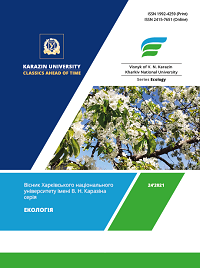Вміст важких металів в організмах герпетобіонтних членистоногих тварин на території полігонів твердих побутових відходів міста Харкова
Анотація
Дослідження є першою ланкою вивчення питання акумуляції важких металів комахами, як складової трофічних ланцюгів. Визначено видовий склад герпетобіонтних членистоногих – 21 вид з 15 родин. На території Роганського полігону 15 видів з 12 родин, а Дергачівського –12 видів з 8 родин. Проведено зонування території за ступенем трансформації ландшафту та визначено структуру розміщення видового складу герпетобіонтів відповідно до зон. Визначено основні закономірності зональної диференціації видів на техногенно порушених територіях. В результаті оцінки трапляємості видів на досліджуваних територіях виокремлено 7 домінантних видів на двох полігонах, в організмах яких визначено вміст важких металів. Визначено, що ландшафтні умови та екологічна ситуація впливає на видовий склад герпетобіонтної фауни прямим чином, що стверджує монодомінантність видів на обох полігонах.
Зональне розміщення та чисельність дослідженої фауни на двох полігонах відрізняється, що свідчить про високу чутливість її до різних умов середовища. Кількісні показники важких металів в організмах членистоногих свідчать про потенційну безпеку цих тварин на полігонах ТПВ для їх консументів.
##submission.downloads##
Опубліковано
Номер
Розділ
Ліцензія
Авторське право (c) 2021 Дементєєва Я. Ю., Андрусенко Л. Ю., Мухіна О. Ю., Чепурна Н. П.

Ця робота ліцензується відповідно до Creative Commons Attribution 4.0 International License.
Автори, які публікуються у цьому журналі, погоджуються з наступними умовами:
- Автори залишають за собою право на авторство своєї роботи та передають журналу право першої публікації цієї роботи на умовах ліцензії Creative Commons Attribution License 4.0 International (CC BY 4.0), котра дозволяє іншим особам вільно розповсюджувати опубліковану роботу з обов'язковим посиланням на авторів оригінальної роботи та першу публікацію роботи у цьому журналі.
- Автори мають право укладати самостійні додаткові угоди щодо неексклюзивного розповсюдження роботи у тому вигляді, в якому вона була опублікована цим журналом (наприклад, розміщувати роботу в електронному сховищі установи або публікувати у складі монографії), за умови збереження посилання на першу публікацію роботи у цьому журналі.
- Політика журналу дозволяє і заохочує розміщення авторами в мережі Інтернет (наприклад, у сховищах установ або на особистих веб-сайтах) рукопису роботи, як до подання цього рукопису до редакції, так і під час його редакційного опрацювання, оскільки це сприяє виникненню продуктивної наукової дискусії та позитивно позначається на оперативності та динаміці цитування опублікованої роботи (див. The Effect of Open Access).

